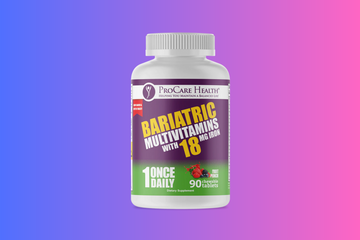

ProCare Health’s Dye-Free Products
You spoke; we listened! In response to the evolving needs of our valued customers and after receiving fantastic feedback on our dye-free options, such as our Calcium Soft Chew and Multivitamin Chew, we’re excited to expand our range of dye-free products.
Soon, you’ll be able to enjoy our customer-favorite Fruit Punch Chewable Multivitamin as a dye-free version!
In light of this change, we’d like to share some important details with you!
Why Are Artificial Dyes Used?
While many artificial food dyes and additives are considered generally recognized as safe (GRAS) by the Food and Drug Administration (FDA), there are still many individuals who choose to avoid or limit their intake. This can be due to allergies, sensitivities, or a preference for more natural options.
Artificial dyes were first used to enhance and correct natural colors or even out the color of a product. They were also used as a way to identify a flavor. For example, red often means a berry, cherry, or strawberry type of flavor, while an orange color is often orange or citrus. They were also used to compensate for the natural color loss during manufacturing and exposure to light, air and temperature.
Artificial food dyes can be found in candy, sports drinks, soda, baked goods, pickles, smoked salmon, salad dressing, medication, and nutritional supplements. The consumption of artificial food dyes has increased by 500% per person in the US since 1955, and there is no known health benefit or nutritional benefit of using artificial food dyes.
What Are Artificial Food Dyes Made From?
Food dyes are chemical substances and have been added to food for centuries, but the first artificial food colorings were created from coal tar in 1856. Many dyes have been created over the years, and some were found to be toxic. Nowadays, only a handful of dyes are still used in food, and these are made from petroleum. These have gone through testing for toxicity in animal studies and are deemed to pose no significant health risk by the FDA and the European Food Safety Authority (EFSA).
The following food dyes are approved for use by both the FDA and EFSA.
- Blue #1 is a greenish-blue dye used in canned peas, ice cream, icings, packaged soups, and popsicles.
- Blue #2 is royal blue and used in candy, cereal, ice cream, and snacks.
- Red #3 is cherry-red and used in cake-decorating gels, candy, and popsicles.
- Red #40 is dark red and used in candy, cereals, condiments, and sports drinks.
- Yellow #5 is a lemon-yellow and used in candy, chips, cereals, popcorn, and soft drinks.
- Yellow #6 is an orange-yellow and used in candy, baked goods, sauces, and preserved fruits.
The most popular food dyes are Red 40, Yellow 5, and Yellow 6, making up 90% of all the food dyes used in the US.
What Is the Concern About Food Dyes?
While the dyes mentioned above are considered acceptable for human consumption by the FDA and EFSA, they are banned from human consumption in other countries, making it extremely confusing to assess their safety.
Many food additives that are used in the US are banned from many countries worldwide due to strong scientific evidence linking them to significant health harm. A 2010 report from the Center for Science in the Public Interest (CSPI) concluded that 9 artificial dyes approved for use in the US are likely carcinogenic, cause behavioral problems and hypersensitivity reactions, or are not adequately tested.
The studies that have evaluated the safety of food dyes and cancer have been long-term animal studies. While most food dyes did not cause any adverse effects in toxicity studies, there is some concern regarding possible contaminants in the dyes that have been linked to cancer. The bottom line is that there is currently no conclusive evidence that artificial food dyes cause cancer. More research is needed, with the exception of Red #3, which has been shown to cause an increase in thyroid tumors in rats.
A 2021 report by the California Environmental Protection Agency’s office found that consuming synthetic (artificial) food dyes may result in hyperactivity and other neurobehavioral concerns in children. While there may be some scientific evidence linking hyperactivity and neurobehavioral concerns in children to artificial food dyes, there does appear to be a genetic component, and not all children have the same response. The bottom line is that some children might be more sensitive to dyes than others, and parents have to choose what they feel is best for their child.
A few food dyes, the most commonly being Red #40, Yellow #5, and Yellow #6, have been shown to cause allergic reactions in some individuals. These reactions typically manifest as hives or asthma symptoms and are rarely life-threatening. Still, if you suspect a food dye allergy, consider eliminating artificial food dyes from your diet.
What Are the Alternatives?
There are many alternatives now available to manufacturers to utilize instead of artificial food dyes. Some of those alternatives include beet juice, fruit juices, spirulina extract, and turmeric.
Are There Any Concerns With Natural Dyes?
You may notice some variation in the color of the tablets. This is normal and can occur from tablet to tablet or batch to batch due to the use of natural colorants. These variations are influenced by factors like harvest season, weather conditions, and the time of year.
While the safety of artificial food dyes is very controversial, and the research is not exhaustively conclusive, there is no health or nutritional benefit to using food dyes. What’s more, there are many other alternatives when it comes to artificial dyes available to food, pharmaceutical, vitamin/supplement, and candy manufacturing companies today.
Our Commitment at ProCare Health
At ProCare Health, we feel it is our responsibility to continually monitor available options and provide high-quality products while remaining affordable to promote long-term adherence to supplementation. For these reasons, we have decided to expand our selection of dye-free products.
We believe you shouldn’t have to choose between good nutritional supplements and products without dyes. By making this change, you will still receive the same high-quality product with the same taste.
The only difference that you may notice more variation in the color of the tablets. This is normal and can occur between tablets or from batch to batch due to the use of natural colorants, which are influenced by harvest season and other factors.
Please reach out with any questions or concerns. Our resident Bariatric Dietitian Nutritionist would be happy to chat!









